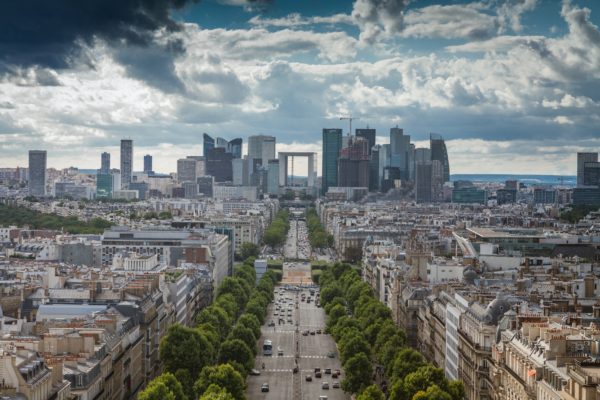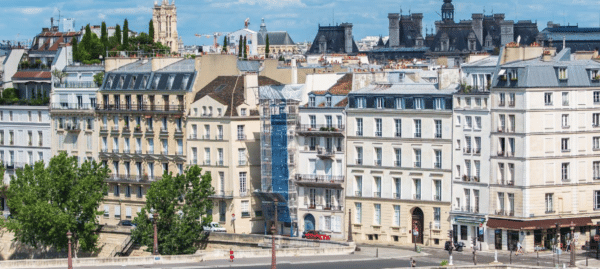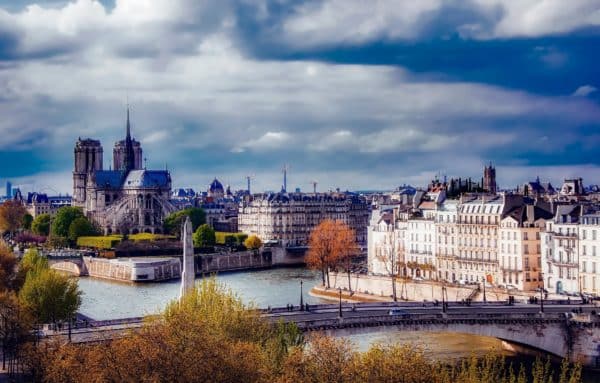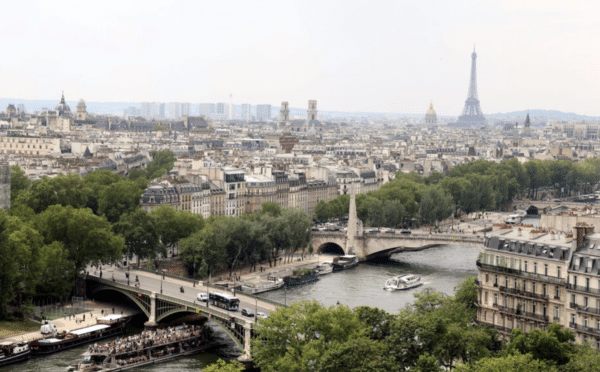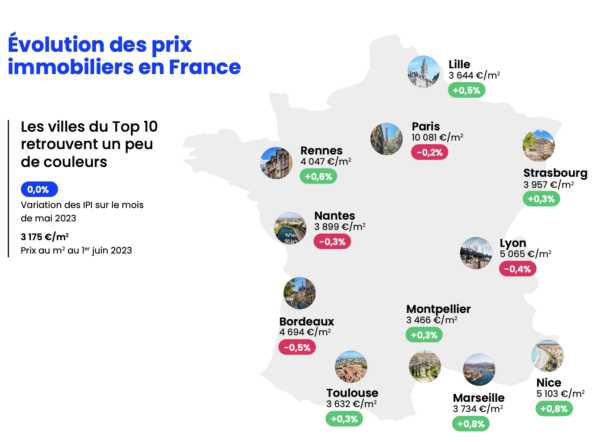Expert Insight, Breaking News, and Insider Stories on Real Estate in Paris
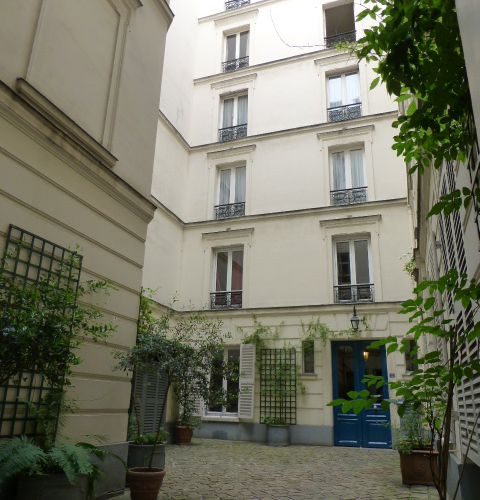
Paris Buildings: A Brief History
Paris, France, is an unusually coherent architectural creature. Paris’ modern buildings have developed gradually out of earlier styles; palaces and mansions have survived by transforming into apartments and shops, and most streets harbor a range of buildings from various centuries. Our Paris guide traces a millennium of building in Paris, and what’s amazing is that so much remains visible and integrally important to the way that Paris works, from the earliest Medieval period through the most contemporary constructions.
Paris evolved out of a walled city, and some historians argue that this alone has given Paris a certain logic that London or Boston lacks. Paris has really never lost its walls: 900 years after the 12th-century wall of Philippe August, we now live in a city walled by its ring-road, the Péripherique highway. This succession of walls, gradually torn down and rebuilt through the centuries, has created a spiraling city, which grew gradually out from the Ile de la Cité. It’s not surprising that some of the oldest buildings are near the center of the spiral.
The Medieval Period (1100-1526)
In 52 BC, the Romans defeated a tribe called the Parisii and established a city they named Lutetia, which probably means “swampy.” Today, that city is Paris—and it’s still swampy in the springtime! Traces of Roman architecture remain visible in Paris: if you look at a map, Rue Saint-Jacques cuts right through the middle of the city and was the main Roman road in and out. But when the Roman Empire crumbled, its architectural genius disappeared as well, and the Dark Ages were actually a step backwards architecturally. During the early Middle Ages, the people of Paris sometimes stole and relocated entire sections of Roman walls to use for their own buildings, because the Roman walls were so much sturdier. During this entire period, the “architect” per se didn’t yet exist, and important Paris buildings were designed and constructed by teams of masons.
Most surviving medieval architecture in France is religious; this is partly a question of durability: the earliest secular buildings were roughly built, often using flammable wood and straw, whereas religious buildings were made to last with stone, built for the glory of God. In France, as in much of Europe, churches evolved through a series of styles beginning with the Romanesque. This early tradition featured a wide central aisle or nave, usually flanked with narrow aisles on each side. Be sure to visit the Saint-Germain-des-Prés Church, one of the few remaining churches in Paris that has retained its Romanesque shape. It dates back to the 10th-century, the truly Dark Ages.
By the 1100s, three unique engineering improvements appeared in Paris and France and created a new, Gothic style. These three innovations were: pointed arches, which can carry more weight than Romanesque round arches; cross vaults, or X-shaped ribbing growing up from columns inside the arch, for better support; and flying buttresses, which channel the weight of the roof and walls to the ground, allowing walls to be thinner and opening them up for windows. The Basilique Saint-Denis (1140-1144) in nearby Saint Denis was the first of the great Gothic Cathedrals; here in Paris, Notre Dame, begun by the Bishop de Sully in 1163, was the first to appear. Sully claimed that Notre Dame appeared to him in a vision, but it’s more likely he was trying to compete with Saint-Denis, to ensure that Paris remained the most important Christian city in the area.
Soon after Notre Dame was completed, Paris suffered such a disastrous series of events that any other city would have given up. Along with nearly constant warfare, the year 1315 brought so much rain that the Church declared a new Flood. In the following years, there were a series of crop failures so disastrous that the period is now believed to have been a miniature Ice Age. And during the plague-filled winter of 1348, 800 Parisians died per day. A third of Paris’ population was wiped out. The desperate times show in the buildings: you’ll notice shutters, very small windows, and well-bolted heavy doors protecting inner courtyards. While parts of Italy were entering the Renaissance in the 1400’s, Paris was still recovering from the Hundred Years War. No wonder people barricaded themselves behind crenellated walls and prayed for deliverance.
The Renaissance (1515-1643)
In 1515, Francis I took over the French throne, to the immediate benefit of Parisian art and architecture. Francis was a great art lover and reader (unlike several previous monarchs, who were functionally illiterate), and he surrounded himself with the best creative minds of the time. He invited Leonardo da Vinci to Paris and hired Italian architects to renovate the Louvre. With Francis, the Renaissance arrived in Paris with a bang. He was the French equivalent and contemporary of England’s Henry VIII, without the multiple wives; the French capital surged with life and new buildings. Renaissance ideas insisted on a sense of human proportion in all the arts, including architecture. As a result, buildings of this time can be read as metaphors for the human shape: their solid base is the foot of the building, the elegant middle is the building’s body, and the peak of the roof, with gabled windows, is the hat. These carefully-proportioned ideas really initiated the concept of Classical architecture in Paris.
Unfortunately, when Francis died in 1547, the city was torn apart by Catholic and Protestant factions. A Protestant king, Henri IV, finally brought peace to Paris once he had converted to Catholicism (it’s Henri who apparently said “Paris is worth a Mass.”) He rode into Paris in 1594, finding a city ruined by violence. Determined to restore its brilliance, he completed the Pont Neuf, extended the Louvre (partly to please his new Catholic bride, Marie de Medicis) and reorganized the entranceways of the city. His most beautiful public legacy is the Place Royale (see below), but private real estate also took off at this time. New neighborhoods were developed by Louis le Barbier, who appears to be the original French real estate developer. Le Barbier established elegant neighborhoods in the Latin Quarter, the Faubourg Saint-Germain, and the Quartier du Palais-Royal (Rue Saint-Honoré) by constructing magnificent private urban chateaux known as “hôtels,” which he then sold to nobles.
French Baroque and Classicism (17th Century)
Everyone has heard the word “baroque” but in Paris it’s easy to see what the style actually refers to. Although Baroque first appeared in Italy in 1590, it reached its apogee in France 50 years later, under the omnipotent reign of Louis XIV (who reigned 1643-1715). The style’s emphasis on grand floor plans, superhuman massive figures, and the illusion of infinite distance were qualities that suited the Sun King, who used architecture to reflect his political clout. His great palace of Versailles is essentially Baroque, and it was designed as the king’s seat of power partly because Louis disliked Paris. He had suffered through a turbulent childhood regency and he distrusted the city. He left urban planning to his superintendent of finance, Jean-Baptiste Colbert, who understood the symbolic importance of Paris.
Colbert was incorruptibly honest, which made him loathed by everyone, but he was a visionary for Paris planning. He knew that Louis XIV needed Paris to represent his power, much as Rome represented the might of the Roman Empire. So Colbert commissioned buildings inspired by Rome; Classicism makes its first conscious appearance in Paris during this time. Order, sumptuous functionality, and the principles of Palladio defined Classical buildings. This style gained ground especially in the 18th and 19th Centuries, and we’ll visit several examples later. But for this period, the most clearly Classical of Colbert’s legacies is the Hôtel des Invalides, begun in 1671. The famous dome of the Invalides was directly inspired by St. Peter’s in Rome, and the overall design of the Invalides complex is Classical. But standing at the front entrance of Invalides, you can also see how Baroque combined well with the Classical style. The Baroque influence gave us the symmetrical wings, strong window treatments, and monumentality of the building. In some of the hôtels (now embassy buildings) that line the esplanade of Invalides, you’ll notice a new French invention of this period: the Mansard roof, the distinctive double-sloped roof line created by François Mansart (1598-1666). Small oval windows often poke out from these roofs and are known as “oeil de boeuf” windows.
Rococo (1715-1774)
For a while, it seemed that Louis XIV would live forever. When the Sun King finally died, the Baroque style was as exhausted as the overtaxed peasants. Louis’ great-grandson, Louis XV, a mere child, took the throne in 1715, just as Paris was beginning a new period of intellectual fermentation known as the Enlightenment. While Voltaire and Rousseau wrote of man’s necessary freedom, architecture changed to complement the new ideals. The refined, nature-inspired curves of Rococo became popular.
The word “Rococo” is believed to be a combination of the French words for grotto rock (“rocaille”) and shell (“coquille”); the sinuous line of grottoes and shells were imitated as ornamentation in this style. Some of the great hôtels of this period include the Hôtel de Matignon, where the Premier of France now lives, and the Hôtel d’Evreux, residence of the President. In 1748, at the height of the style, Jacques-Ange Gabriel designed Place Louis XV, which we now know as Place de la Concorde; clearly, Classicism still held power over architects’ imaginations. Hôtel de la Vrilliere, now part of U.S. Embassy, was built during the same period. Along with decorative details and a desire for lightness, the Rococo brought improvements in practical aspects of architecture: chimneys became more efficient, sanitation was improved, and rooms were arranged with more consideration for privacy. Residential life was creeping closer to what we would recognize today.
Neo-Classicism (late 18th- early 19th-century)
Just as fashion flips from skinny to baggy, architecture also often flip-flops from one extreme to the other, so after the frivolous and light-filled Rococo, buildings were pared back to classical symmetry. As the doomed reign of Louis XVI began, Paris entered a period of Neo-classicism. This severe style was inspired by intense study of Roman and Greek architectural theories. As a result, Neo-classicism is very intellectual, unlike the emotional moodiness that characterized the Rococo period. This style also reflects a desire for plain, unadorned materials, combined with extremely logical floor plans and design.
Even when Louis XVI lost his head, his style of Neo-classicim continued unchanged. This is partly because the Revolution was chaotic, with little opportunity for architects to invent a new style. But Neo-classicism also corresponded to Revolutionary aspirations—democracy was born in Athens and Rome, so the classic architecture of those times was still very relevant. What’s fascinating about Neo-classicism is its incredible versatility: after surviving Louis XVI and the Revolution, the style managed to continue through Napoleon’s Empire. When Bonaparte came to power, first under the Directoire and eventually as Emperor, he used classical references to validate his dream of Paris as the center of a new Roman Empire. Neo-classicism dominated the city, leaving us today with a surprising collection of Doric, Ionic, and Corinthian pillars on every sort of Parisian building.
“That summer of 1789 when the Bastille was destroyed and its stones transformed into souvenirs—as [people] would sell the concrete fragments of the Berlin Wall, exactly two centuries later.” —writer Eric Hazan, L’Invention de Paris, 2002.
Consulate, Empire, and Restoration (1803-1840)
The Revolution devastated Paris and the city’s architecture suffered alongside its people. Royal chambers were torn apart by mobs, churches were looted and demolished, and ordinary apartments burned. With the end of the Terror in 1794, thousands were released from prison. As the brutality faded, a new flippancy swept the city. Wealthy young fops called “Incroyables” appeared, partnered by scandalously-dressed “Merveilleuses.” A 5-man Directoire was set up while Emperor-to-be Napoleon directed campaigns in Italy, Austria, and Egypt. By 1802, the Directoire had collapsed and the Consulate had been usurped by Napoleon, who named himself Consul for Life. Two years later, he was Emperor, Josephine his temporary Empress, and their extended family was ensconced in the Tuileries Palace. Barely a decade after decapitating Louis XVI, Parisians had acquired a new royal family, which set about establishing a new aristocratic tone for the city.
The Napoleonic style is a mishmash of Neo-classic impulses. Decoration was stimulated by excavations in Pompeii and archeological discoveries in Greece. Classical references pleased Napoleon, since they suited his ambitions for an expanding Empire. Napoleon wisely set up massive building projects to keep Parisians employed, and his largest urban projects shaped today’s city. Napoleon started construction on Père Lachaise cemetery, had parts of the Tuileries and the Louvre rebuilt, began the Madeleine, and ordered the Ourq Canal dug. Napoleon also ordained that streets should be numbered odd on one side, even on the other, a remarkably practical concept that hadn’t occurred to anyone before.
But Napoleon’s Empire turned out to be brief: by 1815, he was exiled permanently, and his capital city had grown to a very crowded 715,000 people. The Coalition which defeated Napoleon placed King Louis XVIII on the throne, a gouty old man who had few illusions of omnipotence. His most important architectural contribution wasn’t stylistic but practical: under his reign, 21,000 new Parisian apartment buildings were constructed. He died calmly in office in 1824, unleashing a period of great unrest. Riots left hundreds dead, barricades were set up in the streets, and new sections of the city caught fire. People who remembered the Revolution wondered if it was all going to happen again. But the Industrial Revolution was gradually changing the economic structure of Paris, and in 1830, the Duc d’Orleans, a former banker, became King. Louis-Philippe attempted to establish an Orleans style in architecture, but his reign was too short to have a major impact. He is responsible for finishing the Madeleine Church, along with the grandiose Galerie des Batailles in Versailles.
The Haussmann renovations under the Second Empire & the early Third Republic (1840- early-20th-century)
The Second Empire was a peculiar dream invented by a short man with a big moustache, named Louis Napoleon. A nephew of the original Napoleon, Louis attempted to seize the French throne in 1836 and 1840, failing on both occasions. But despite his moustache wax, he was not completely feckless: he escaped from prison and bided his time in London. While he was there, he admired the urban fabric of the city and spent time walking in Hyde Park.
In 1848, French politics were once again in disarray, Paris was in revolt, and Louis seized his chance. He returned to France and got himself elected to Parliament. He manipulated his way into the presidency, but his vision was much more ambitious. In 1851, he seized power in a coup d’etat and a year later became Emperor Napoleon III. His dream had become reality. But his capital city was a wreck; it looked nothing like his fond memories of London. Paris traffic was snarled, its housing unsanitary, and worst of all, there were no real public parks.
Napoleon needed someone to take on the renovation of Paris. By sheer luck, he found the perfect man for the job in Baron Georges Eugène Haussmann. Tall, honest and good-looking, the Baron must have been a curious match for Louis Napoleon as they studied plans of the city and discussed what needed to be done. By 1853, the city’s population had skyrocketed to over 1 million. Only one house in five had any running water; of these, most only had plumbing on the ground floor.
Haussmann understood the desperate need to reorganize the city: he had grown up during the terrible cholera epidemic of Paris, which killed 20,000 inhabitants. Impressed with the Baron’s efficiency, Napoleon III gradually placed all major Paris administration in his capable hands.
Haussmann succeeded in turning Paris into a functioning Imperial city despite an incredibly short period of control: by 1870, the Baron was in disgrace. His Imperial boss threw him to the dogs in a desperate effort to save his own political skin, but later that same year, Louis Napoleon was taken prisoner by the Prussians. And the Hôtel de Ville, symbol of Haussmann’s power, was set on fire by an enraged mob. Yet, Haussmann is the most enduring and successful city planner Paris has ever known. His apartment buildings remain the Parisian standard, his sewage system still works, and his reorganization of city boulevards has allowed Paris traffic to creep into the 21st century. The city’s beauty, with its splendid London-inspired Bois de Boulogne and Vincennes, remains the sole truly great accomplishment of Napoleon III.
Art Nouveau (1893-1917)
Art Nouveau was a brief but exquisite fin-de-siecle architectural trend lasting approximately from 1893 to the beginning of World War I. The name for the style comes from an art gallery opened in 1900, when German-born Parisian S. Bing opened a shop near Galeries Lafayette called “L’Art Nouveau Bing.” The press quickly seized on the label. From the mid- 1800s, industrial building materials had revolutionized construction, but architects were slow to change their style. Heavy overwrought versions of Haussmann buildings remained the norm. A few innovative young architects across Europe took a fresh look at the new steel, iron, and concrete available. They realized that these new materials could emphasize the way a building was put together instead of using a heavy facade to conceal the inner architectural structure. The new materials allowed architects to free the interior space of a building, opening the way to Modernism.
The essential name of the period was Hector Guimard, today remembered for his famous Métro entrances. The Paris transport authority hired him in 1896. Guimard’s curving “cigarette smoke” line had already made waves in the elegant 16th arrondissement, but his Art Nouveau was motivated by a social conscience, much like the Arts and Crafts Movement in Britain. He leapt at the chance to design something beautiful for the masses. Of course, when Guimard unveiled his brilliant Métro work in 1900, everyone hated it. The shiny green color he had chosen to emulate nature was considered unpatriotic, too close to Prussian green, and the writhing insect-like metalwork was much too weird for the public. Time has defeated his critics however, and Guimard’s Art Nouveau Métro entrances have become one of the city’s trademarks.
Art Deco and the Modern Movement (1918-39)
At the end of World War I, a new aesthetic began to bubble up in Paris. It was optimistic—the world had just survived “the war to end all wars” and people were exuberant. Paris hummed with wealthy visitors and artistic innovations. High-speed ocean liners crisscrossed the Atlantic; Surrealism shocked the art world; radios poured out jazz music. The Modern Age had arrived. Trying to express this freedom and movement, architects responded to the jazzy rhythm with angular shapes reminiscent of the new cruise ships. Their style was termed Industrial Moderne, Jazz Moderne or Streamline Moderne; it was only in the 60s that the term Art Deco was coined, but this is the name that has stuck to the movement. Art Deco first appeared in Paris and reached its greatest heights in New York during the 20s and 30s. World War II put an end to Art Deco’s optimism; the less-flamboyant lines of pure Modernism took over. But at the beginning, in the 1920s in Paris, the two styles overlapped, particularly in private houses designed in newly-developing residential areas of Paris such as Boulogne and Montsouris.
There was a housing boom all over the city, especially at its edges. The city wall of Adolphe Thiers, built in 1851 and made obsolete soon afterwards when the city limits were changed by Haussmann, was finally completely demolished after World War I. The new empty space was quickly filled with housing projects, many of them government-sponsored and built of brick. The new housing was influenced by the sharp angles and setbacks of Art Deco, with decorative brickwork and intelligent layouts. These brick buildings became known as “the red belt,” because they were brick-colored and inhabited by socialist workers, in a belt at the edge of the city.
Post War through the Seventies
These years are often seen as a disaster for French architecture. This isn’t entirely fair, although some terrible mistakes were made, in particular the destruction of Les Halles in central Paris. But even after ripping out the guts of the city, one phoenix rose from the ruins. Renzo Piano and Richard Rogers created the superb Centre Georges Pompidou on the square that had once been Les Halles’ parking lot for delivery trucks. The brightly-hued building changed the course of European architecture and made the careers of the two young partners, who have gone on to build fantastic buildings around the world. Their Beaubourg concept pushes all the utilities and services to the outside of the building in order to free up enormous exhibition spaces within. Whether you love it or hate it, Beaubourg has a delightful feeling of fun, its purpose-coded colors sparkling again after its 2000 renovation. The problem with many buildings from this period is that they never had a sense of humor and they have aged badly.
Although the Pompidou stands out radically from its neighbors because of its style, its height isn’t much taller than them. Paris remains largely 8-stories high. In order to keep taller buildings from ruining the skyline, a sort of architectural apartheid was introduced during this period. While low-rise Paris remained pristine, skyscrapers were sent to La Defense, a futuristic suburb just beyond the Arc de Triomphe. The first plan appeared in 1964 and was criticized for being dull; the second plan put forward much higher and more dramatic buildings and was approved in 1968. This business-oriented suburb covers about 1,000 hectares; today, some of the towers are beautiful, some ugly, and construction continues, always carefully planned. Unfortunately, other outlying areas of Paris have had to endure far less thoughtful experiments and are mutilated with residential turrets. There is no redeeming word to be said for the crumbling, supposedly Modern, architectural wrecks that litter the outlying areas of eastern Paris. It is these mistakes that have given the entire period a bad reputation.
Contemporary, 1980 to Present
In the 1980s, President Mitterrand unveiled a new architectural concept to move Paris into the next millennium. His “grands travaux” brought both praise and horror as they evolved, but no one can deny that the final result is a renewed and thrillingly diverse city. Mitterrand is responsible for commissioning the Grand Louvre’s new glass pyramid entrance (created by I.M. Pei), the move of the Ministry of Finance into a new building (designed by Paul Chemetov), the Grande Arche de la Defense (by Von Spreckelsen), the Cité de la Musique (by Pritzer-prize winner Christian de Portzamparc), the Institut du Monde Arabe (by Jean Nouvel), the Opera Bastille (by the less-accomplished Carlos Ott), and the new library (by Dominique Perrault), now named after the grand master puppeteer himself as the Bibliotèque François-Mitterrand. Not all of these buildings were successful (the Opera Bastille stands out as a particular blot on the landscape), but overall, Mitterrand’s desire to make Paris a contemporary architectural star turned out to be a resounding success. Some of the most exciting names in the industry are now French (see below) d if the mayor of Paris can successfully improve the city’s circulation problems, the future for Paris architecture is looking very bright indeed.
By Lisa Pasold
Contact Paris Property Group to learn more about buying or selling property in Paris.














